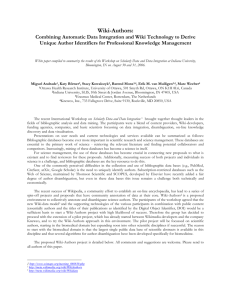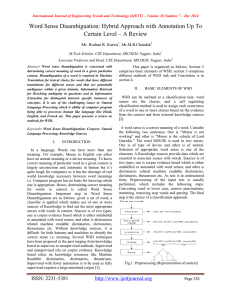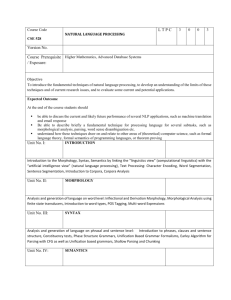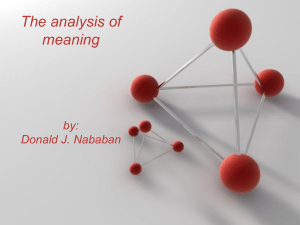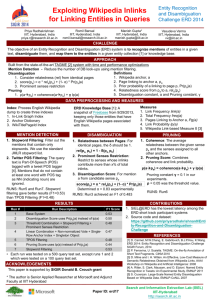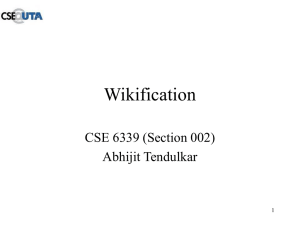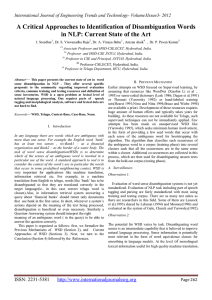Document 13135783
advertisement
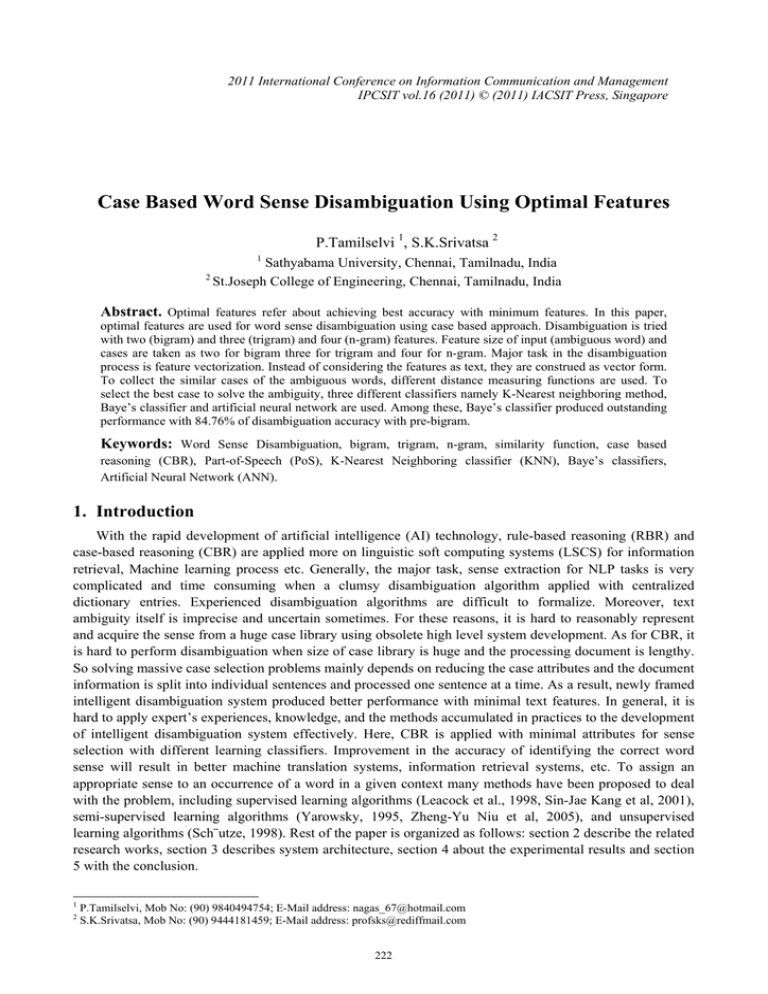
2011 International Conference on Information Communication and Management
IPCSIT vol.16 (2011) © (2011) IACSIT Press, Singapore
Case Based Word Sense Disambiguation Using Optimal Features
P.Tamilselvi 1, S.K.Srivatsa 2
1
2
Sathyabama University, Chennai, Tamilnadu, India
St.Joseph College of Engineering, Chennai, Tamilnadu, India
Abstract. Optimal features refer about achieving best accuracy with minimum features. In this paper,
optimal features are used for word sense disambiguation using case based approach. Disambiguation is tried
with two (bigram) and three (trigram) and four (n-gram) features. Feature size of input (ambiguous word) and
cases are taken as two for bigram three for trigram and four for n-gram. Major task in the disambiguation
process is feature vectorization. Instead of considering the features as text, they are construed as vector form.
To collect the similar cases of the ambiguous words, different distance measuring functions are used. To
select the best case to solve the ambiguity, three different classifiers namely K-Nearest neighboring method,
Baye’s classifier and artificial neural network are used. Among these, Baye’s classifier produced outstanding
performance with 84.76% of disambiguation accuracy with pre-bigram.
Keywords: Word Sense Disambiguation, bigram, trigram, n-gram, similarity function, case based
reasoning (CBR), Part-of-Speech (PoS), K-Nearest Neighboring classifier (KNN), Baye’s classifiers,
Artificial Neural Network (ANN).
1. Introduction
With the rapid development of artificial intelligence (AI) technology, rule-based reasoning (RBR) and
case-based reasoning (CBR) are applied more on linguistic soft computing systems (LSCS) for information
retrieval, Machine learning process etc. Generally, the major task, sense extraction for NLP tasks is very
complicated and time consuming when a clumsy disambiguation algorithm applied with centralized
dictionary entries. Experienced disambiguation algorithms are difficult to formalize. Moreover, text
ambiguity itself is imprecise and uncertain sometimes. For these reasons, it is hard to reasonably represent
and acquire the sense from a huge case library using obsolete high level system development. As for CBR, it
is hard to perform disambiguation when size of case library is huge and the processing document is lengthy.
So solving massive case selection problems mainly depends on reducing the case attributes and the document
information is split into individual sentences and processed one sentence at a time. As a result, newly framed
intelligent disambiguation system produced better performance with minimal text features. In general, it is
hard to apply expert’s experiences, knowledge, and the methods accumulated in practices to the development
of intelligent disambiguation system effectively. Here, CBR is applied with minimal attributes for sense
selection with different learning classifiers. Improvement in the accuracy of identifying the correct word
sense will result in better machine translation systems, information retrieval systems, etc. To assign an
appropriate sense to an occurrence of a word in a given context many methods have been proposed to deal
with the problem, including supervised learning algorithms (Leacock et al., 1998, Sin-Jae Kang et al, 2001),
semi-supervised learning algorithms (Yarowsky, 1995, Zheng-Yu Niu et al, 2005), and unsupervised
learning algorithms (Sch¨utze, 1998). Rest of the paper is organized as follows: section 2 describe the related
research works, section 3 describes system architecture, section 4 about the experimental results and section
5 with the conclusion.
1
2
P.Tamilselvi, Mob No: (90) 9840494754; E-Mail address: nagas_67@hotmail.com
S.K.Srivatsa, Mob No: (90) 9444181459; E-Mail address: profsks@rediffmail.com
222
2. Related Works
Text features are playing vital role in all kind of natural language processing (NLP) tasks such as word
sense disambiguation (WSD), Machine translation (MT), information retrieval (IR) etc. Commonly used text
features are morphological text, PoS of the word, surrounding words, location collocations, verb-noun
relation etc. (Hwee tou Ng, 2007) three different teams were involved to make the disambiguation process
based on supervised learning concept. CITYU-HIF team used Naïve Baye’s classifier with text features part
of speech of the words, single words in the surrounding context classifier, HIT-IR-WSD team used support
vector machine with a linear kernel function with text features POS of surrounding words, local collocations,
single words in the surrounding context and syntactic relations and the third team PKU used support vector
machine with maximum entropy classifier with POS of surrounding words, local collocations and single
words in the surrounding context. (Zheng-Yu Niu et al, 2007) used three types of features, part-of-speech of
neighboring words with position information, unordered single words in topical context, and local
collocations as same as the feature set used in (Lee and Ng, 2002) except the syntactic relations. If the
occurrence frequency of a feature was less than three then, it was removed from feature set. (Marine et al,
2008) used word sense disambiguation task to improve the statistical machine translation. For doing WSD,
they used the text features of position sensitive, syntactic and local collocation features for getting best
disambiguation performance.
(Pedersen, 2001) experimented the use of bigrams for WSD with a decision tree and naive Bayes
classifier. He tested different bigrams that occur close to the ambiguous words (within approximately 50
words to the left or right of the ambiguous word) as possible disambiguation features. He applied statistical
method to disambiguate texts using decision tree with bigram concept. (Zhimao Lu et al., 2004) extracted
mutual Information (MI) of the words as input vectors for back-propagation neural network. The network is
tested with maximum feature sets varying from ten words from left and ten from right with respect to
ambiguous word.
Common problems faced in natural language processing are data sparseness and inconsistency in
vocabulary. When the number of features increases, the sparseness is unavoidable. Smoothing is really
required to overcome the above problem for improving the performance. To avoid sparseness, minimal
features bigram, trigram and n-gram with four features are adopted and compared here. This paper presents a
system to disambiguate words using case based reasoning with minimal features. With CBR, the solution for
the problem is derived by comparing the current problem description with a set of past cases maintained in
case-bases, represented as distributed E-dictionaries (P.Tamilselvi et al, 2009).
3. System Architecture
Disambiguation system architecture is described with feature vector representation and sense
disambiguation.
Column
C1
C2
C3
C4
C5
C6
Fields
case
Sense_value
Sense_tag
l3l2l1
W
r1 r2 r3
Description
ambiguous word
WordNet
WordNet
Weight of
Weight of
Weight of
Sense value
Sense tag
immediate three
ambiguous word
immediate right
left words
three words
Fig.1: Structure of distributed Case-Base
3.1.
Feature vector representation
In general, input of bigram is ambiguous word with either previous (post-bigram – T1) or immediate
next word (pre-bigram – T2), in trigram ambiguous word with two immediate right words (pre-trigram – T3),
or with one word from left and right (in-trigram – T4) or with two immediate left words (post-trigram – T5)
and in n-gram (T6), two left words one right word along with ambiguous word at third position. When inputs
are taken as text, process complexity would be high. To avoid it, weight of PoS of the inputs is taken in the
223
form of vector of size 1×2 (bigram) 1×3 (trigram) and 1×4 (n-gram). Hence, weight assignment process is
an important task. PoS notations from Brown corpus are pursued to categorize (by eliminating POS and NPS)
them into seventeen groups and weights are assigned for the groups with values .01 to .17. Input text features
(PoS) are replaced by their relevant weight with the condition 0.0001is assigned for absence of any feature
(left or right word). For example, the sentence, ‘He is working as a manager in a bank”, here, ambiguous
words {work, manager, bank} are isolated and each of their relevant vectors of bigram, trigram and n-gram
are framed. Cases are in electronically distributed form. Totally 26 distributed casebases used to maintain
cases based on their starting character. For example, the case ‘bank’ is maintained under the casebase ‘B’. A
case is represented with six fields (Fig-1). In the casebase, C1 is the case word, C2 & C3 together are
solution for the case, C4, C5 & C6 are used for case feature vector (F1, F2, F3 and F4) representation (Table1).
Table.1: Case feature vector representation
3.2.
Feature type
F1
F2
F3
F4
Number of
features taken
Post-Bigram
l1
W
-
-
2
Pre-Bigram
W
r1
-
-
2
Pre-Trigram
W
r1
r2
-
3
In-Trigram
l1
W
r1
-
3
Post-Trigram
l2
l1
W
-
3
n-gram
l2
l1
W
r1
4
Sense disambiguation
Consider a document D is given as input for the system. Pre-disambiguation process is applied for the
document to split it into sentences Si (i=1,2,..N). Next, split Si into individual morphological words Wj
(j=1,2..,M), N is total number of sentences and M is total number of words in sentence Si. Collect all
ambiguous words of the Wi for disambiguation. Frame vectors of bigram, trigram and n-gram of ambiguous
words (input vectors). Select the ambiguous word one at a time and find the appropriate casebase of it and
filter the cases having C1 value as input ambiguous word and frame case vectors from their respective
features. Three different distance metric functions such as Euclidean, cityblock and cosine are used to select
the minimal distance of case with input word and finally three different classifiers, namely, K-nearest
neighboring classifier (KNN), Baye’s classifier and artificial neural network (ANN) are used to extract the
best case from the minimal distance cases and produce the relevant case’s solution part as sense for the input
word. Sense disambiguation algorithm is given in Fig-2.
Table 2 Disambiguation Accuracy in %
Distance
Learning
Metric
Classifier
T1
T2
T3
T4
T4
T6
Maximum
Functions
Euclidean
Cityblock
Cosine
K-NN
78.18
69.05
77.39
71.83
71.04
80.16
80.16
Bayes
76.2
84.77
72.62
76.2
78.97
80.96
84.77
ANN
65.48
69.85
62.7
66.27
58.34
63.5
69.85
K-NN
78.18
72.62
77.39
71.83
71.04
80.16
80.16
Bayes
78.97
81.75
72.62
76.2
81.75
77.39
81.75
ANN
32.15
69.05
62.7
57.15
59.13
59.13
69.05
K-NN
81.75
66.27
77.39
71.83
63.89
76.59
81.75
Bayes
78.97
75.4
69.85
76.2
78.18
77.39
78.97
ANN
68.26
63.5
66.27
63.5
59.13
62.7
68.26
224
Chart-1: Disambiguation Time
1. Get the document D with N sentences.
∑
2. For i=1:N
%
%
[row col] = size(
for j = 1:col
1,
%
_
%
%
_
for k=1:3
for l=1:3
end % for index l
end % for index k
end % for index j
end % for index i
Fig.2: Sense Disambiguation Algorithm
4. Experimental Results
Testing document is taken form Brown Corpus. Even though the sentences in Brown Corpus are sense
tagged, we didn’t consider the same PoS, because, individual words are framed as compound word and for
that PoS is assigned. In our algorithm, all words should be individual, so parsing is done separately using
Hidden Markov Model (P.Tamilselvi et al., 2010). Main purpose of this disambiguation system is to produce
better result with minimal features. The performance of the system is measured using multiple scales.
Disambiguation accuracy is measured and compared using three different distance metric functions together
with three different learning classifiers (Table-2). From the table it is clear that, the minimal feature prebigram (T2) produced 84.77% disambiguation accuracy by Baye’s classifier with Euclidean function.
Sentence is categorized into two types based on its length, length with less than or equal to ten words are
grouped into segment 1 (seg-1) and more than ten words are as segment 2 (seg-2). Disambiguation accuracy
is measured based on the length of a sentence (Table-3). Table-3 values projects that pre-bigram (T2) vector
225
yielding 100% accuracy for seg-1 and 84.76% for seg-2 with Euclidean as well as City-block using Baye’s
classifier. Disambiguation time is also calculated using ‘tic-toc’ command with an assumption no other task
should be assigned to CPU. Still, the disambiguation time is not fixed always, so we did the disambiguation
process five times for each word and average of that is taken as disambiguation time for that word. Chart-1
shows the disambiguation time. KNN with all three functions for all 6 features took less time, Bayes
classifier with Euclidean and cityblock functions took less time for all six types of features but cosine
distance function took a little more time for the feature types T3, T4, T5 and T6. With ANN, the three
functions took more time for T3, T4, T5 and T6 and overall accuracy performance is less.
5. Conclusion
In this paper, disambiguation system is implemented with three different set of features with three
different distance measuring functions combined with three different classifiers for word sense
disambiguation. The system is used on a document, means one paragraph. At the end of execution of the
system, sentencewise ambiguous words and their sense are listed. Using Neural Networks with enormous
number of features, accuracy measured from 33.93% to 97.40% for words with more than two senses and 75%
of accuracy for words with two senses (A. Azzini, C. da Costa Pereira, M. Dragoni and A. G. B. Tettamanzi,
2008). Here,case based disambiguation accuracy of 84.77% made us to recommend pre-bigram feature type
with Euclidean distance function together with Baye’s classifier as better approach for disambiguation. The
system can be extended for doing disambiguation process on a document with more than paragraph.
Table 3 Disambiguation Accuracy based on sentence length
Distance
Learning
Metric
Classifier
Seg-1
Seg-2
T1
T2
T3
T4
T5
T6
T1
T2
T3
T4
T4
T6
K-NN
83.333
83.333
83.333
66.667
83.333
83.333
78.175
69.048
77.381
71.825
71.032
80.159
Bayes
83.333
100
83.333
83.333
83.333
83.333
76.19
84.76
72.619
76.19
78.968
80.952
ANN
58.333
66.667
54.167
58.333
16.667
41.667
65.476
69.841
62.698
66.27
58.333
63.492
K-NN
83.333
83.333
83.333
66.667
83.333
83.333
78.175
72.619
77.381
71.825
71.032
80.159
Bayes
83.333
100
83.333
83.333
83.333
83.333
78.968
84.76
72.619
76.19
81.746
77.381
ANN
58.333
66.667
54.167
66.667
41.667
54.167
32.143
69.048
62.698
57.143
59.127
59.127
K-NN
83.333
83.333
83.333
66.667
83.333
83.333
81.746
66.27
77.381
71.825
63.889
76.587
Bayes
83.333
100
83.333
83.333
83.333
83.333
78.968
75.397
69.841
76.19
78.175
77.381
ANN
58.333
66.667
70.833
66.667
41.667
29.167
68.254
63.492
66.27
63.492
59.127
62.698
Functions
Euclidean
Cityblock
Cosine
6. References:
[1] Ng, Hwee Tou, & Chan, Yee Seng, 2007, English Lexical Sample Task via English-Chinese Parallel Text.
Proceedings of the 4th International Workshop on Semantic Evaluations, SemEval 2007, pp. 54 – 58.
[2] Zheng-Yu Niu, Dong-Hong Ji, Chew Lim Tan, 2007, Learning model order from labeled and unlabeled data for
partially supervised classification, with application to word sense disambiguation. Computer Speech & Language
21(4): 609-619.
[3] Zhimao Lu, Ting Liu, and Sheng Li. 2004, Combining neural networks and statistics for Chinese word sense
disambiguation. In Oliver Streiter and Qin Lu, editors, ACL SIGHAN Workshop 2004, pages 49-56.
[4] Leacock, C., Chodorow, M., and Miller, G. A., 1998, Using corpus statistics and WordNet relations for sense
identification. Computational Linguistics, 24, 1.
[5] Sin-Jae Kang, Jong-Hyeok Lee, 2001, Ontology Word Sense Disambiguation by Using Semi-Automatically
Constructed Ontology, Machine Translation Summit VIII, pp. 181-186.
[6] David Yarowsky, 1995, Unsupervised Word Sense Disambiguation Rivaling supervised methods, in proceedings
of the 33rd annual meeting on Association for Computational Linguistics (ACL 1995).
226
[7] Sin-Jae Kang, Jong-Hyeok Lee, 2001, Ontology Word Sense Disambiguation by Using Semi-Automatically
Constructed Ontology, Machine Translation Summit VIII, pp. 181-186.
[8] Hinrich Schütze, 1998, Automatic Word Sense Discrimination, Computational Linguistics, 24(1).
[9] Y. K. Lee and H. T. Ng. 2002, An Empirical Evaluation of Knowledge Sources and Learning Algorithms for Word
Sense Disambiguation. In Proc. of EMNLP.
[10] Marine CARPUAT, Dekai WU, 2008, Evaluating the Word Sense Disambiguation Performance of Statistical
Machine Translation, LREC 2008
[11] T. Pedersen, 2001, A decision tree of bigrams is an accurate predictor of word senses, in: Presented at Second
Annual Meeting of the North American Chapter of the Association for Computational Linguistics, 2001.
[12] P.Tamilselvi, S.K.Srivatsa, 2009, Decentralized E-Dictionary (DED) for NLP task, Proceedings of ICMCS
International conference on Mathematics and computer Science, India, 2009
[13] P.Tamilselvi, S.K.Srivatsa, Part-Of-Speech Tag Assignment Using Hidden Markov Model, International Journal
of Highly reliable Electronic System, Vol 3, No 2, 2010.
[14] A. Azzini, C. da Costa Pereira, M. Dragoni, and A. Tettamanzi. Evolving Neural Networks for Word Sense
Disambiguation, HIS’08, pages 332-337, LNCS, Springer, Septermber 2008.
227
